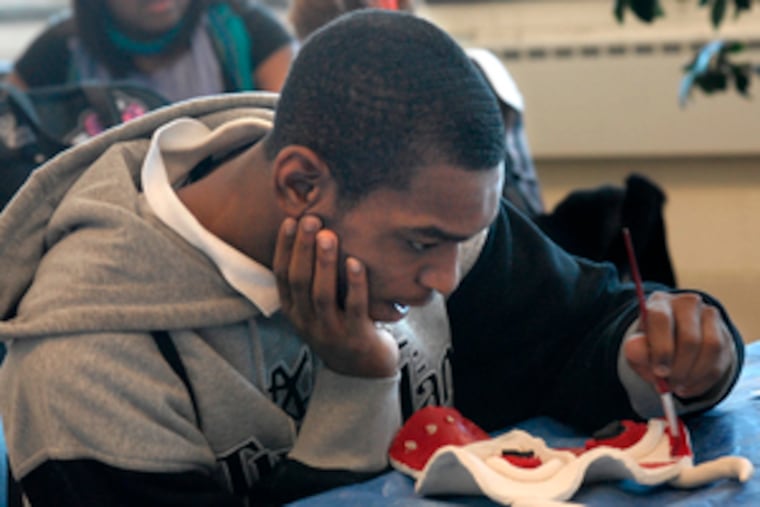Kristen Graham | Helping to mold students' interest in art
The Claymobile teaches high school students to work with clay to give them "something they're happy about."

Harmony Thompson and Yvonne Lung wheeled their cart past the metal detector and down the long hallway, onto the elevator, and into the art room.
When Dorothy Johnson saw the supplies they unloaded - bottles of paint, glitter, colorful feathers, brushes, glue, scissors, and dozens of pieces of hardened, polished ceramic - she lit up.
The Claymobile had come to Strawberry Mansion High.
The outreach arm of the Clay Studio, a city nonprofit group specializing in education and promotion of the ceramic arts, sent Thompson and Lung to the school to open students' eyes to a new medium.
"I love to create," Johnson, a senior, said on a recent day. "There's so much you can do with clay."
Through a grant from the Christopher Ludwick Foundation, the Claymobile visited Strawberry Mansion and Kensington High Schools one day a week for six weeks. Artists and teachers, Thompson and Lung taught an art class at Strawberry Mansion, helping students start with lumps of terra cotta or white clay and go on to eventually produce three finished works. Francisco Hernandez and Harriet Hoover worked with social studies students at the Kensington school.
After Thompson, Lung and Clay Studio outreach coordinator Hoover readied their supplies and threw blue tarpaulins over the tables, they got to work.
Thompson gave them instructions on finishing their pieces and selecting materials.
"This is a poster paint, and it's not waterproof," Thompson told the class, holding three small jars aloft. "Make sure you don't wipe it with a sponge."
She reminded the students to label their work and that each of them will have a piece entered in a show at the Clay Studio in February. Then she set them to work.
When Dalina Hayes saw her finished work for the first time, she was delighted.
"I didn't think it would come out like this," Hayes said, showing art teacher Marilyn Dix a mask she had sculpted and painted brown and black.
Hayes, a junior, had to change her schedule and get special permission to attend the Claymobile classes. It was worth it, she said.
"It's fun. It's different," said Hayes. "I've never done anything like this before, and I'd like to keep doing it."
Dix sees the Claymobile as a gift. When Thompson and Lung arrive, students are excited, eager to come to class.
"It's wonderful," said Dix. "I don't know enough about clay to do this myself. What an opportunity."
The students in her class have plenty of exposure to two-dimensional work, she said, but almost none with three dimensions.
"There are a lot of kids who may not be good at drawing, but they're really shining at clay," said Dix.
Junior David Dingle is a clay convert.
"I love patterns, and I think a lot about color. But I never knew I could do stuff like this," Dingle said of his work.
Claymobile has shifted his perspective, Dingle said. "I'm thinking about going to college for this," he said.
That would be icing on the cake, said Hoover of the Clay Studio, but the point of the program is not to produce sculptors or even professional artists.
"We like to think that we reach kids, but even if we just give them something they're happy about, that's great," she said. "They have to grow up so fast."
There are opportunities for students who show promise and interest - from the Strawberry Mansion class, Dorothy Johnson soon will begin working for the Claymobile, assisting with after-school programs.
Ashante Johnson considers herself a creative person, but working with clay was both challenge and joy, she said, showing off a brown-and-yellow saucer and cup with a twisty handle she planned to give to her mother.
"It was hard. I had something in mind, but it came out different than I imagined it on paper," she said, dabbing royal blue paint onto her mask.
"I'm not an artist, but my teachers are great teachers. They told us, 'Be creative. Your work doesn't have to be like everyone else's,' " Ashante Johnson said.
Across from her, Crystal Bush nodded.
"I usually hate art, but this was awesome," Bush said. "Painting, sculpting. I love it."
Pausing between cleaning brushes and talking with students about their work, Lung said her job was not to compel students but to help inspire them.
"I try not to direct them, but to let them do what they intuitively feel like doing," Lung said. "It's important to say, 'What is it you want? What do you want to say?' "
Thompson said she enjoys watching students progress from tentative teenagers to confident artists.
"They don't want to do it - it's too messy, and they're afraid," she said. "But eventually, they make the clay move the way they want it to. It builds confidence. It's exciting for them to see what they've made."
Just then, Renard Wright got up and said, "We appreciate what you did. You're a good teacher."
Thompson looked around the room and smiled at the class.
"You did a lot of hard work," she said. "You should be proud."